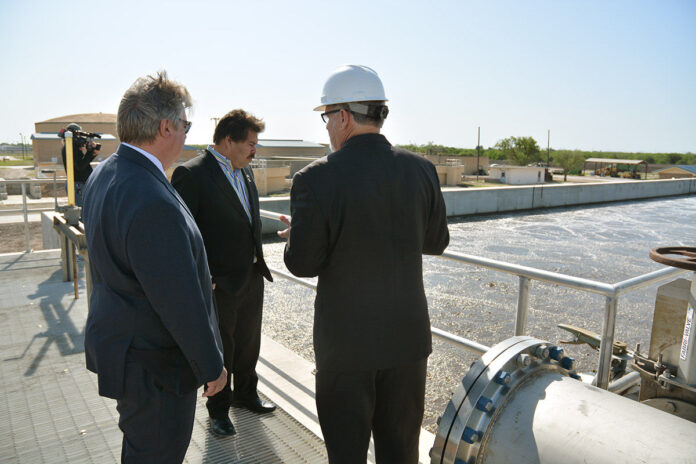HARLINGEN — City officials today dedicated new Wastewater Treatment Facility No. 2 which cost $43 million less than originally projected in 2008.
Engineering consultants for the plant, located on 54th Street, came in with an estimate of $57 million in 2008 when told the city would need a new treatment facility.
Today officials announced the new plant has come in at a cost of $14.5 million, a savings they attributed to a commitment to do much of the work and engineering in-house within the Harlingen WaterWorks System which oversees wastewater treatment.
“We’re operating, we’re operating successfully, and when we add up all of the costs we spent over the past nine years, from the projected $57 million, our total project cost to date is $14 million … a total savings of over $43 million to the City of Harlingen,” said Josh Fields, chair of the WaterWorks board of directors.
City officials likewise praised the WaterWorks’ department commitment to performing much of the work needed in-house instead of outsourcing it.
“What a remarkable feat of engineering has occurred here,” said Mayor Chris Boswell. “A smart, fiscally responsible, pay-as-you-go way to save this community nearly $40 million and to have a brand new wastewater treatment facility at a fraction of the cost of what the experts told the city and the WaterWorks board what it would cost 10 years ago.
“On behalf of the City Commission .. on behalf of this community and this city, I cannot thank the staff of WaterWorks enough for this tremendous achievement that I think will go down in the history of our community as one of the greatest achievements that should be recognized,” he added.
How wastewater is treated
Primary treatment removes 40 to 50 percent of solids from the wastewater. The wastewater passes through bar screens, which allows water to pass, but not trash such as rags or sticks. The trash is collected and properly disposed of. Next comes the grit chamber, which is a large tank that slows down the flow of water in order to allow the sand, grit and other heavy solids to settle to the bottom which are later removed. Then it’s on to a primary sedimentation tank which allows the smaller particles to settle.
The secondary treatment completes the process, so that 85 to 90 percent of the pollutants are removed. It starts by reaching an aeration tank to supply large amounts of air to the mixture of wastewater, bacteria and other microorganisms. Oxygen is needed to help the microorganisms grow, which consume harmful organic matter in the wastewater. The wastewater then reaches a secondary sedimentation tank, which allows the microorganisms and solid waste to form clumps and settle. The last step occurs when a disinfectant such as chlorine is added to the wastewater before it leaves the treatment facility. The disinfectant kills disease-causing organisms in the water.
After treatment, the water can be safely returned to nearby waterways. It can also be used on land for agriculture and other purposes.
Source: Harlingen WaterWorks System
How we got here
2008 — A Wastewater Master Plan prepared by a national engineering consultant proposes a new wastewater plant and 8,550 feet of 36-inch gravity sewer line at a projected cost of $57,118,000.
2011 — The 36-inch gravity sewer line is completed.
2011 — Completion of new headworks facility.
2012 — Process and structural design of the new wastewater treatment plan begins.
2013 — Relocation of wastewater service operations to Wastewater Treatment Plant No. 2
2015 — Construction of Wastewater Treatment Plant No. 2 begins.
2017 — New treatment plant transitions to online operations.
2017 — Solids/sludge improvments for the new wastewater treatment plant to be completed by end of the summer. Total cost: $14.5 million.




